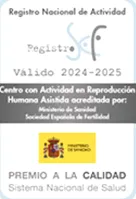ROPA
Method
What is the
ROPA method?
Process and Technique of the ROPA Method
The ROPA method of In Vitro Fertilisation is a variant of IVF designed for women with female partners. It involves extracting and fertilising the eggs of one of them with donor sperm and implanting the resulting embryo into the uterus of her partner.
The difference of the ROPA method compared to the other two treatments is that it is a more attractive option because both women actively participate in the creation and birth of the baby.
ROPA METHOD: DOUBLE MATERNITY
The fertilisation and development of the embryo take place in the laboratory of Clínicas Eva, where they mimic the conditions of the moment of fertilisation as it occurs in a woman’s uterus.
Both women play a crucial role: one will be the biological mother (providing the egg) and the other will be the gestational mother (the one who becomes pregnant and gives birth).
FIRST ATTEMPT SUCCESS RATE
Study of success gestational
Study that we provide to you prior to the treatment, so that you are aware of the possibilities you have to achieve success in pregnancy in each cycle of In Vitro Fertilisation Method Ropa.
Fertility Studies

Ovarian stimulation
In the natural process of a female menstrual cycle, women produce a single oocyte (egg) each month. Through the administration of medication, what we aim for in this first phase of In Vitro Fertilisation is to stimulate the ovary and induce the production of more oocytes.
If the creation of many oocytes is achieved, the possibility of gestation is greater as more embryos can be obtained. We monitor the progress of this process through periodic ultrasound checks, and occasionally blood tests.

FOLLICULAR PUNCTURE
When a transvaginal ultrasound shows that the follicles are of adequate size for a mature oocyte to have developed inside, the follicular puncture is scheduled. A hormone is also administered that induces oocyte maturation in a manner similar to how it occurs in the natural cycle.
Approximately 36 hours will have to pass from the medication until we perform the puncture. The puncture is performed in the operating room, under sedation so that the woman does not feel any discomfort, and involves extracting the mature oocytes, a process that lasts approximately 10-15 minutes.

IVF and Embryo Culture
Once the oocytes have been extracted through puncture, and with the sperm previously selected from the couple, the insemination of the oocytes in the laboratory proceeds.
When fertilisation occurs, the embryos are left in culture for 5 to 6 days. During this entire time, the embryologists monitor and evaluate the development of the embryos using timelapse incubators.

Embryo transfer
Embryo transfer is the final and decisive step. It is a crucial phase of the treatment.
The specialist prepares the patient’s uterus with medication and ensures that it has the correct thickness for embryo implantation. On the 5th or 6th day of embryo culture, the highest quality embryo is transferred to the uterus through a simple procedure performed in the operating room. Using a specific and flexible catheter, to avoid damaging the walls of the uterine cavity, the embryo is deposited into the uterine cavity. No sedation is needed as it is not a painful procedure.
After the embryo transfer, the patient will rest for a few minutes and can resume her daily activities, always in moderation.
The surplus embryos from the process will be frozen, in order to avoid repeating the ovarian stimulation and follicular puncture process again, in case you do not get pregnant in the first cycle of In Vitro Fertilisation.

Subsequent process
Approximately two weeks after the embryo transfer, a pregnancy test is performed by measuring beta-HCG in the blood. In case the beta is positive, a follow-up ultrasound is performed to confirm the gestational sac.
How long does
the ROPA method?
The IVF treatment lasts approximately 30 days, the time may vary depending on the stage of the cycle each woman is in and their synchronisation. Additionally, prior to the treatment, tests will be conducted to make the treatment as personalised as possible. These tests are focused on achieving the couple’s dream, so the final duration may vary depending on each patient’s situation.
When to turn to
Ropa Method (IVF)?
In cases of lesbian couples seeking pregnancy, both members of the couple are a fundamental part of achieving the dream.
LEADERS IN OVARIAN AND ENDOMETRIAL REJUVENATION
GET PREGNANT WITH YOUR OWN EGGS
Ovarian Rejuvenation
Ovarian Rejuvenation is a specific treatment to improve the quantity of the patient’s eggs. It involves injecting into the ovaries an infusion of plasma rich in growth factors, obtained from the patient’s own blood platelets.
HYPERBARIC CHAMBERS
Hyperbaric medicine uses hyperbaric oxygen at a higher than normal pressure, promoting an increase in the concentration of oxygen in the patient’s blood. In fertility, there are studies for both men and women that demonstrate that hyperbaric oxygen benefits fertility.
UTERINE REJUVENATION
Growth factor-rich plasma is also beneficial for the uterus due to its regenerative and reparative properties. It is obtained from the patient’s own blood platelets, concentrating all the factors into a small portion of plasma to then infuse into the uterus.
WHEN WILL THE RESULTS BE AVAILABLE?
The results after the first plasma injection can be noticed in the first consecutive IVF cycle, but depending on the patient, a second treatment with growth factor-rich plasma may be needed.
LEADERS IN OVARIAN AND ENDOMETRIAL REJUVENATION
GET PREGNANT WITH YOUR OWN EGGS
Ovarian Rejuvenation
Ovarian Rejuvenation is a specific treatment to improve the quantity of the patient’s eggs. It involves injecting into the ovaries an infusion of plasma rich in growth factors, obtained from the patient’s own blood platelets.
HYPERBARIC CHAMBERS
Hyperbaric medicine uses hyperbaric oxygen at a higher than normal pressure, promoting an increase in the concentration of oxygen in the patient’s blood. In fertility, there are studies for both men and women that demonstrate that hyperbaric oxygen benefits fertility.
UTERINE REJUVENATION
Growth factor-rich plasma is also beneficial for the uterus due to its regenerative and reparative properties. It is obtained from the patient’s own blood platelets, concentrating all the factors into a small portion of plasma to then infuse into the uterus.
WHEN WILL THE RESULTS BE AVAILABLE?
The results after the first plasma injection can be noticed in the first consecutive IVF cycle, but depending on the patient, a second treatment with growth factor-rich plasma may be needed.

PLAN EVA
FINANCE YOUR PREGNANCY AT 100%
We know that every treatment involves an emotional and financial cost. That’s why we finance your pregnancy interest-free.
Faqs
Should women be married to practice the Ropa Method?
No, previously yes, but since last year it is not necessary. The Spanish Society of Fertility states that access to the ROPA method cannot be conditioned by the civil status of the female couple, as it would constitute discrimination prohibited by the Constitution and the Assisted Reproduction Law itself.
Can you choose the sperm donor?
No. In Spain, gamete donation is completely anonymous. We guarantee the greatest similarity between the appearance of the donor and the gestational mother, always under medical criteria and according to what the law establishes.
Who gets pregnant and who donates eggs?
In principle, this is personal, and it will be decided as a couple. However, the doctors can determine which one has the healthiest eggs to be the donor.
Get informed at your nearest EVA Clinic. Your medical consultation is always free.

